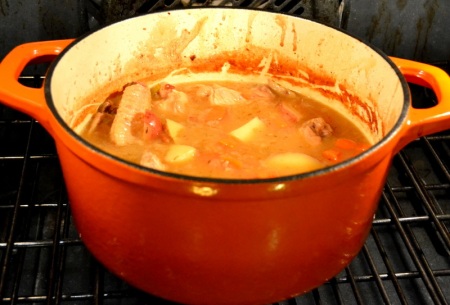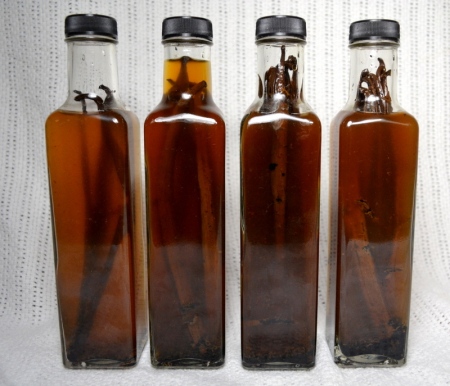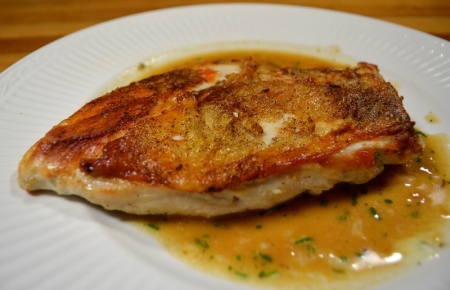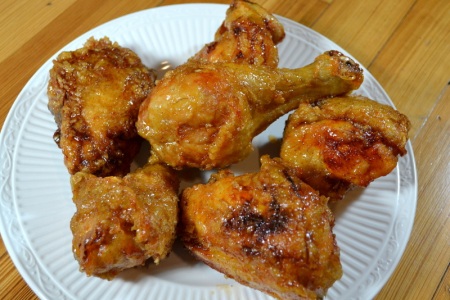I have tried to make fudge in the past, but have never been successful and always found it extremely fussy. Chris Kimball has devised an easy 15-minute fudge, which I’ve very successfully made a few times; see here and here. Simultaneously to Chris Kimball publishing his easy 15-minute fudge recipe in 2007, he also published this old-fashioned fudge recipe. My years of successfully following Chris Kimball’s recipe has given me renewed confidence in making traditional Christmas fudge; candy thermometer and all. Unfortunately, one small mis-read left me with burnt fingers and grainy fudge.

Delicious, but near catastrophe
Overall, fudge making is a slow process, and that slowness is supposed to ensure a smooth texture. I remember reading somewhere that Chris Kimball tested 1,000 pounds of chocolate to come up with this recipe, which he claimed to have perfected. First off, you need to be sure you have the right equipment: candy thermometer, pastry brush, wooden spoon, Dutch oven and a 13”x 9” baking dish (117 square-inches). I had a 14″x10″ baking dish (140 square-inches), so I used cardboard to reduce the volume by 20%. (see photo at bottom of post).
Most things in the recipe were clear, except for two crucial steps. In Step 7, I misread his instructions and didn’t realize that I was supposed to dunk the syrup-covered handle into the ice batch to cool. Instead, I burner my fingers and never got the syrup to form any kind of ball. Finally, I removed the pot from the stove-top when the temperature read 242-degrees, because that was already too hot. Secondly, step 9 and 10 were extremely unclear as to how long I should lift and stir fudge. After just 5 minutes (was expecting 8 to 12 minutes), my fudge had seized up and I had to re-heat it to get it to spread into my pan. The time period between glossy and solid was about 30 seconds. I’m assuming that the issue was because I over-heated the fudge because I misread step 7.
Overall, I can only give the results 2-stars, because of the dry, grainy texture.
UPDATE ON 12/24: By putting each piece of fudge in the microwave for ten seconds, the texture becomes soft and the Fudge jumps from 2-to-4-stars. Not good enough to give away to friends and neighbors, but good enough to eat myself.
Comments:
- This recipe makes 4 pounds of fudge. Fudge is one of those recipes that you cannot double.
- I found this website filled with helpful fudge-making hints.
Rating: 2-stars.
Cost: $10
How much work? Medium.
How big of a mess? Medium.
Start time 2:00 PM. Ready at: 7:00 PM.
Chris Kimball’s original recipe is here. The descriptions of how I prepared the recipe today are given below:
6 tablespoons unsalted butter
12 ounces unsweetened chocolate (3 bars)
4-1/2 cups granulated sugar (31-1/2 ounces; 1/2 oz under 2 pounds)
1-1/2 cups light brown sugar (10-1/2 ounces)
1 teaspoon table salt
3 tablespoons chocolate syrup
2-1/4 cups whole milk
1 tablespoon vanilla extract
- Cut your butter into 1/2″ cubes. Roughly chopped your chocolate and divide into two equal 6 ounce parts. Place butter cubes and 6 ounces chocolate in freezer.
- To keep your utensils clean during the preparation, fill a large saucepan 3/4 full with water and heat on medium-low burner until bubbles just begin to form, then reduce burner to low to keep water warm. Put your candy thermometer, pastry brush, and wooden spoon in warm water. Prepare a medium bowl with ice and cold water, which you will also use to keep your utensils clean. Later, you will need to fill sink 1″ deep with room-temperature tap water, so make sure the sink is clean.
- Fold an 18” piece of aluminum foil and fold it lengthwise into an 8” by 18” strip. Lay foil into 13″x9″ baking dish. Pushing foil into corners and sides allowing the excess to hang over the pan ends. Next fold a 14” long piece of aluminum foil (If foil is more than 12″ wide fold it to fit pan) and put in pan perpendicular to first sheet of foil.
- Put a large Dutch oven over medium burner and heat sugars, salt, chocolate syrup, milk, and remaining unfrozen 6 ounces chocolate for 6 to 12 minutes, constantly stirring with wooden spoon, until the chocolate melts. Clean wooden spoon with hot running tap water to remove all sugar crystals, then set spoon in container filled with ice water with the handle-side down.
- Using pastry brush to wash down any sugar crystals that form on the sides of the pot, dipping brush back into hot water before wiping down another part of pot Continue washing down the sides of pot until no sugar crystals remain. Attach candy thermometer to side of pot and continue to cook until syrup boils; about 2 to 3 minutes.
- Boil sugar for 30 minutes until it reaches 236 degrees, then start to test for doneness. Avoid stirring the fudge once it has reach the boiling stage, unless you notice that a thick edge of syrup that is not boiling, briefly stir the syrup with a clean wooden spoon.
- To test for doneness, dip the wooden spoon’s handle (from ice bath) into syrup, sweep and twist a few times to coat the end of the handle times until enough chocolate adheres to the spoon handle. Dunk into ice bath and wait 5 to 10 seconds to cool down (twist the handle as necessary so that syrup doesn’t fall off), then gather the syrup with your fingers and attempt to roll up into a ball. The syrup will be done when it forms a soft ball that will flatten when lightly pressed between two fingers. Continue to cook until syrup forms a soft ball, checking every 2 degrees. (Total cooking time should be about 40 minutes). Meanwhile, make sure your kitchen sink has 1″ of room-temperature tap water.
- Remove Dutch oven from burner and immediately put into prepared sink. Sprinkle frozen butter cubes, chocolate and vanilla over the fudge. Cool in sink for 5 minutes, then move to counter and allow to cool, without stirring, for another 25 to 35 minutes until the fudge reaches 110 to 120 degrees.
- Use the wooden spoon to combine all the ingredients, then once or twice clean the perimeter of the pot. Lift a spoonful of mixture 1 foot above pot and allow to drip back into the pot, repeating the lifting process 5 times. Allow to rest for 1 minute.
- Repeat the lifting/resting process in step 9 for between 8 to 12 minutes until the fudge loses its shine and becomes difficult to stir.
- Quickly empty the fudge into the prepared pan and use a spatula to spread into an even layer. If the fudge sets too soon and crumbles when you try to spread it into the pan, reheat it over medium-low heat, stirring constantly, until some of the sugar melts and the fudge becomes more fluid.
- Cool fudge at room temperature for 4 hours until it becomes firm. Use the foil overhang to remove the fudge from the pan and cut into squares. Tightly wrapped in waxed paper or plastic, the fudge can be stored for up to 2 weeks in a cool cabinet or 3 months in the freezer.

Foil-lined baking dish

Used my favorite brand of chocolate

Reduced pans volume to keep fudge’s thickness




 Posted by My Year With Chris Kimball
Posted by My Year With Chris Kimball 














